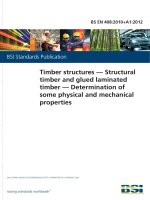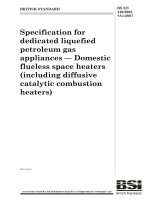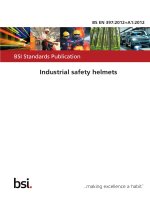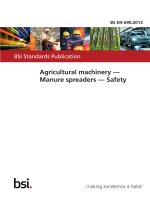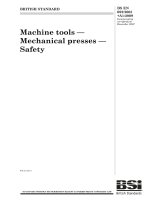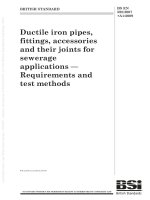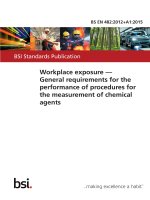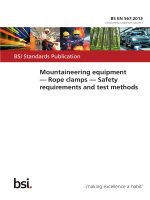Bsi bs en 16254 2013 + a1 2016
Bạn đang xem bản rút gọn của tài liệu. Xem và tải ngay bản đầy đủ của tài liệu tại đây (1.04 MB, 24 trang )
BS EN 16254:2013+A1:2016
BS EN 16254:2013
BSI Standards Publication
Adhesives — Emulsion
polymerized isocyanate
(EPI) for load-bearing timber
structures — Classification and
performance requirements
BS EN 16254:2013+A1:2016
BRITISH STANDARD
National foreword
This British Standard is the UK implementation of
EN 16254:2013+A1:2016. It supersedes BS EN 16254:2013 which
is withdrawn.
The start and finish of text introduced or altered by amendment is
indicated in the text by tags. Tags indicating changes to CEN text carry
the number of the CEN amendment. For example, text altered by
CEN amendment A1 is indicated by .
The UK participation in its preparation was entrusted to Technical
Committee PRI/52, Adhesives.
A list of organizations represented on this committee can be obtained
on request to its secretary.
This publication does not purport to include all the necessary provisions
of a contract. Users are responsible for its correct application.
© The British Standards Institution 2016.
Published by BSI Standards Limited 2016
ISBN 978 0 580 91268 9
ICS 83.180
Compliance with a British Standard cannot confer immunity from
legal obligations.
This British Standard was published under the authority of the Standards
Policy and Strategy Committee on 31 October 2013.
Amendments/corrigenda issued since publication
Date
Text affected
30 April 2016
Implementation of CEN amendment A1:2016
EUROPEAN STANDARD
NORME EUROPÉENNE
EUROPÄISCHE NORM
ICS 83.180
EN 16254:2013+A1
April 2016
Supersedes EN 16254:2013
English Version
Adhesives - Emulsion polymerized isocyanate (EPI) for
load-bearing timber structures - Classification and
performance requirements
Adhésifs - Isocyanate polymérisé en émulsion (EPI)
pour structures portantes en bois - Classification et
exigences de performance
Klebstoffe - Emulsionspolymerisiertes Isocyanat (EPI)
für tragende Holzbauteile - Klassifizierung und
Leistungsanforderungen
This European Standard was approved by CEN on 22 June 2013 and includes Amendment 1 approved by CEN on 9 February
2016.
CEN members are bound to comply with the CEN/CENELEC Internal Regulations which stipulate the conditions for giving this
European Standard the status of a national standard without any alteration. Up-to-date lists and bibliographical references
concerning such national standards may be obtained on application to the CEN-CENELEC Management Centre or to any CEN
member.
This European Standard exists in three official versions (English, French, German). A version in any other language made by
translation under the responsibility of a CEN member into its own language and notified to the CEN-CENELEC Management
Centre has the same status as the official versions.
CEN members are the national standards bodies of Austria, Belgium, Bulgaria, Croatia, Cyprus, Czech Republic, Denmark, Estonia,
Finland, Former Yugoslav Republic of Macedonia, France, Germany, Greece, Hungary, Iceland, Ireland, Italy, Latvia, Lithuania,
Luxembourg, Malta, Netherlands, Norway, Poland, Portugal, Romania, Slovakia, Slovenia, Spain, Sweden, Switzerland, Turkey and
United Kingdom.
EUROPEAN COMMITTEE FOR STANDARDIZATION
COMITÉ EUROPÉEN DE NORMALISATION
EUROPÄISCHES KOMITEE FÜR NORMUNG
CEN-CENELEC Management Centre: Avenue Marnix 17, B-1000 Brussels
© 2016 CEN
All rights of exploitation in any form and by any means reserved
worldwide for CEN national Members.
Ref. No. EN 16254:2013+A1:2016 E
BS EN 16254:2013+A1:2016
EN 16254:2013+A1:2016 (E)
Contents
Page
European foreword....................................................................................................................................................... 3
Introduction .................................................................................................................................................................... 4
1
Scope .................................................................................................................................................................... 5
2
Normative references .................................................................................................................................... 5
3
Terms and definitions ................................................................................................................................... 6
4
Classification ..................................................................................................................................................... 7
5
5.1
5.2
5.3
5.4
Requirements ................................................................................................................................................... 9
General ................................................................................................................................................................ 9
Bond strength in longitudinal tensile shear test ................................................................................. 9
Resistance to delamination ...................................................................................................................... 10
Tensile strength perpendicular to the glue line after climatic treatment (acid
damage test)................................................................................................................................................... 11
Effect of wood shrinkage on the shear strength................................................................................ 11
Static load test of multiple glue line specimens in compression shear .................................... 11
Creep deformation test at cyclic climate conditions with specimens loaded in
bending shear ................................................................................................................................................ 12
Long term sustained load test at cyclic climate conditions with specimens loaded
perpendicular to the glue line (“Glass house test”) ......................................................................... 12
5.5
5.6
5.7
5.8
6
6.1
6.2
6.3
6.4
6.5
6.6
6.7
6.8
7
7.1
7.2
7.3
7.4
Test methods ................................................................................................................................................. 12
General ............................................................................................................................................................. 12
Determination of bond strength in longitudinal tensile shear test ........................................... 12
Determination of resistance to delamination.................................................................................... 12
Determination of tensile strength perpendicular to the glue line after climatic
treatment (acid damaged test)................................................................................................................ 12
Determination of the effect of wood shrinkage on the shear strength ..................................... 13
Static load test of multiple glue line specimens in compression shear .................................... 13
Creep deformation test with specimens loaded in bending shear ............................................. 14
Long term sustained load test at cyclic climate conditions with specimens loaded
perpendicular to the glue line (“Glass house test”) ......................................................................... 14
Working properties of the adhesive...................................................................................................... 14
General ............................................................................................................................................................. 14
Determination of working life under reference conditions ......................................................... 14
Determination of open assembly time under reference conditions.......................................... 14
Determination of pressing time under reference conditions ...................................................... 14
Annex A (normative) Climatic treatment prior to shear test ...................................................................... 15
Annex B (normative) Glass house test ................................................................................................................. 16
Annex C (informative) Product limitations and glulam production control for beams
produced with Small Dimension adhesives........................................................................................ 19
Bibliography ................................................................................................................................................................. 20
2
BS EN 16254:2013+A1:2016
EN 16254:2013+A1:2016 (E)
European foreword
This document (EN 16254:2013+A1:2016) has been prepared by Technical Committee CEN/TC 193
“Adhesives”, the secretariat of which is held by AENOR.
This European Standard shall be given the status of a national standard, either by publication of an
identical text or by endorsement, at the latest by October 2016, and conflicting national standards shall
be withdrawn at the latest by October 2016.
Attention is drawn to the possibility that some of the elements of this document may be the subject of
patent rights. CEN [and/or CENELEC] shall not be held responsible for identifying any or all such patent
rights.
This document includes Amendment 1 approved by CEN on 2016-02-09.
This document supersedes EN 16254:2013.
The start and finish of text introduced or altered by amendment is indicated in the text by tags !".
According to the CEN/CENELEC Internal Regulations, the national standards organizations of the
following countries are bound to implement this European Standard: Austria, Belgium, Bulgaria,
Croatia, Cyprus, Czech Republic, Denmark, Estonia, Finland, Former Yugoslav Republic of Macedonia,
France, Germany, Greece, Hungary, Iceland, Ireland, Italy, Latvia, Lithuania, Luxembourg, Malta,
Netherlands, Norway, Poland, Portugal, Romania, Slovakia, Slovenia, Spain, Sweden, Switzerland,
Turkey and the United Kingdom.
3
BS EN 16254:2013+A1:2016
EN 16254:2013+A1:2016 (E)
Introduction
This document is one of a series dealing with emulsion polymerised isocyanate (EPI) adhesives for use
with timber structures, and is published in support of product standards for bonded load-bearing
timber structures.
The series consists of:
— one standard for classification and performance requirements (EN 16254),
— seven test methods (EN 302-1, EN 302-2, EN 302-3, EN 302-4, EN 15416-2, EN 15416-3 and the
method given in Annex B of this standard (“Glass house”)) used to assess the performance of
adhesives after specified heat and humidity treatments, and
— three test methods (EN 302-7, EN 15416-4 and EN 15416-5) to characterise the working properties
of the adhesive.
4
BS EN 16254:2013+A1:2016
EN 16254:2013+A1:2016 (E)
1 Scope
This European Standard establishes a classification for emulsion polymerised isocyanate (EPI)
adhesives according to their suitability for use in load-bearing timber structures in defined climatic
exposure conditions, and specifies performance requirements for such adhesives for the industrial
manufacture of load-bearing timber structures only.
!The performance requirements of this European Standard apply to the adhesives only, not to the
timber structure. This European Standard does not cover the performance of adhesives for on-site
gluing (except for factory-like conditions) nor the production of wood-based panels, except solid wood
panels, or modified and stabilized wood with considerably reduced swelling and shrinkage properties,
e.g. such as acetylated wood, heat treated wood and polymer impregnated wood."
This European Standard is primarily intended for the use of adhesive manufacturers and for the use in
timber structures bonded with adhesives, to assess or control the quality of adhesives. This European
Standard only specifies the performance of an adhesive for use in an environment corresponding to the
defined conditions.
Such an adhesive meeting the requirements of this European Standard for its type is adequate for use in
a load-bearing timber structure, provided that the bonding process has been carried out according to an
appropriate product standard.
2 Normative references
The following documents, in whole or in part, are normatively referenced in this document and are
indispensable for its application. For dated references, only the edition cited applies. For undated
references, the latest edition of the referenced document (including any amendments) applies.
EN 302-1, Adhesives for load-bearing timber structures — Test methods — Part 1: Determination of
longitudinal tensile shear strength
EN 302-2, Adhesives for load-bearing timber structures — Test methods — Part 2: Determination of
resistance to delamination
EN 302-3, Adhesives for load-bearing timber structures — Test methods — Part 3: Determination of the
effect of acid damage to wood fibres by temperature and humidity cycling on the transverse tensile
strength
EN 302-4, Adhesives for load-bearing timber structures — Test methods — Part 4: Determination of the
effects of wood shrinkage on the shear strength
EN 302-7, Adhesives for load-bearing timber structures — Test methods — Part 7: Determination of the
working life under referenced conditions
EN 923:2005+A1:2008, Adhesives — Terms and definitions
EN 15416-2, Adhesives for load bearing timber structures other than phenolic and aminoplastic — Test
methods — Part 2: Static load test of multiple bondline specimens in compression shear
EN 15416-3, Adhesives for load bearing timber structures other than phenolic and aminoplastic — Test
methods — Part 3: Creep deformation test at cyclic climate conditions with specimens loaded in bending
shear
5
BS EN 16254:2013+A1:2016
EN 16254:2013+A1:2016 (E)
EN 15416-4, Adhesives for load bearing timber structures other than phenolic and aminoplastic — Test
methods — Part 4: Determination of open assembly time for one component polyurethane adhesives
EN 15416-5, Adhesives for load bearing timber structures other than phenolic and aminoplastic — Test
methods — Part 5: Determination of conventional pressing time
3 Terms and definitions
For the purposes of this document, the terms and definitions given in EN 923:2005+A1:2008, and the
following, apply.
3.1
emulsion polymerised isocyanate (EPI) adhesive
water based emulsion polymer or a mixture of water based emulsion polymers cross-linked with an
isocyanate as hardener
3.2
service class 1
climatic conditions characterised by a moisture content in the materials corresponding to a
temperature of 20 °C and the relative humidity of the surrounding air only exceeding 65 % for a few
weeks per year
[SOURCE: EN 1995-1-1:2004, 2.3.1.3]
Note 1 to entry: In service class 1, which comprises typical indoor conditions, the average moisture content in
most soft-woods will not exceed 12 %.
3.3
service class 2
climatic conditions characterised by a moisture content in the materials corresponding to a
temperature of 20 °C and the relative humidity of the surrounding air only exceeding 85 % for a few
weeks per year
[SOURCE: EN 1995-1-1:2004, 2.3.1.3]
Note 1 to entry: In service class 2, to which most covered exterior conditions belong, the average moisture
content in most soft-woods will not exceed 20 %.
3.4
service class 3
climatic conditions leading to higher moisture contents than in service class 2
[SOURCE: EN 1995-1-1:2004, 2.3.1.3]
Note 1 to entry:
Exterior conditions typically belong to service class 3.
3.5
glue line
adhesive layer between the wood members
3.6
close contact glue line (cc)
glue line of thickness maximum 0,1 mm
6
BS EN 16254:2013+A1:2016
EN 16254:2013+A1:2016 (E)
Note 1 to entry: Close contact glue line is achieved by pressing together two plane wood members with a
clamping pressure of (0,8 ± 0,1) N/mm2 without groves, spacers or similar device.
3.7
thick glue line
glue line of nominal thickness 0,3 mm to 2,0 mm
Note 1 to entry:
Thick glue lines can be achieved by using spacers, grooves or similar devices.
4 Classification
Adhesives for structural purpose shall produce joints of such strength and durability that the integrity
of the bond is maintained in the assigned service class throughout the expected life of the structure.
EPI-adhesives according to EN 16254 are classified by Type (climate condition in use), Maximum test
temperature and Maximum glue line thickness in use. These three subclasses are subdivided as
follows:
Type I: To be used in service class 1 and 2.
Type II: To be used in service class 1 only.
Maximum test temperature: 50 °C, 70 °C or 90 °C.
Maximum glue line thickness in use: 0,1 mm, 0,2 mm and 0,3 mm.
Depending on the maximum glue line thickness in use, the adhesives are assigned to different
application areas as described below and shown in Table 1.
— General purpose adhesives: to be used for glue lines between laminations (maximum glue line
thickness 0,3 mm) and for finger joints in laminations.
— Small dimension adhesives: to be used in beams with a maximum cross section 45 000 mm2
(maximum glue line thickness 0,2 mm) and for finger joints in laminations. The beam width shall
not exceed 180 mm and the beam height shall not exceed 300 mm.
— Finger jointing adhesives: to be used for finger jointing of laminations and structural timber only
(maximum glue line thickness 0,1 mm).
The application of EPI shall always be in mixed state. These adhesives shall be applied according to the
manufacturer`s instructions.
NOTE
The definition of General purpose and Type could be different in other standards.
7
BS EN 16254:2013+A1:2016
EN 16254:2013+A1:2016 (E)
Table 1 — Adhesive classes
Adhesive type
designation
Application area
Max. test
temperature a
Normal use
Test
General purpose
70
0,5
0,3
1, 2
General purpose
90
0,5
0,3
1, 2
Finger jointing
90
0,3
0,1
1, 2
Special use
EN 16254 I 90 0,2
EN 16254 I 90 0,1
EN 16254 I 70 0,2
EN 16254 I 70 0,1
EN 16254 II 50 0,3
EN 16254 II 50 0,2
EN 16254 II 50 0,1
a
Small dimension
90
Small dimension
0,3
70
Finger jointing
0,3
70
General purpose
0,3
50
Small dimension
0,5
50
Finger jointing
0,3
50
0,3
mm
Service classes
°C
EN 16254 I 70 0,3
EN 16254 I 90 0,3
Max. glue line
thickness
Use
0,2
1, 2
0,2
1, 2
0,1
1, 2
0,3
1
0,2
1
0,1
1
Tested according to EN 15416–2 and Annex A in this standard, designation A6, A7 and A8.
Table 2 specifies the tests which shall be performed for each application area. References are given to
the actual subclause in this standard and to which standard the tests are based on.
Table 2 — Necessary tests for adhesive use in difference application areas
Application
area
General
Purpose
Small
dimension
Finger
jointing
a
b
8
EN 302–
1 (based
on 6.2)a
EN 302–
2 (based
on 6.3)
0,1
X
X
0,5
X
Glue line
thickness
in test
mm
0,3
0,1
0,2
X
0,3
X
0,3
X
0,1
X
X
X
EN 302–
3 (based
on 6.4)
EN 302–
4 (based
on 6.5)
EN 15416–2
(based on
6.6)b
X
X
X
X
X
X
X
X
EN 15416
–3 (based
on 6.7)
X
X
X
Annex B in
this standard
(based on
6.8)
X
X
X
X
X
Climate treatment A1 to A5 and A6 or A7 or A8, depending on maximum test temperature (see Table 1 and Annex A).
Maximum test temperature according to Table 1.
BS EN 16254:2013+A1:2016
EN 16254:2013+A1:2016 (E)
5 Requirements
5.1 General
Adhesives complying with this European Standard shall meet the performance requirements specified
in 5.2 to 5.8 when tested in accordance with the following test methods:
a) The tensile shear test (see 5.2 and 6.2) using bonded test pieces made from beech (Fagus sylvatica
L.).
b) The delamination test (see 5.3 and 6.3) on bonded test pieces made from Norway spruce (Picea
abies L.). If the adhesive is to be used on wood from other conifers species like larch (Larix decidua),
douglas fir (Pseudotsuga menziesii) and pines with coloured heartwood other than scots pine (Pinus
sylvestris), from hardwood species and/or preservative treated wood, also prepare four laminated
members using representative samples from those species or wood treated that way.
c) Tensile strength perpendicular to the glue line after climatic treatment (see 5.4 and 6.4) on bonded
test pieces made from Norway spruce (Picea abies L.). The test will only be mandatory if the pH
value in the mixed adhesive is lower than 3,0.
d) The shrinkage stress test (see 5.5 and 6.5) on bonded test pieces made from Norway spruce (Picea
abies L.).
e) Static load test (see 5.6 and 6.6) on bonded test pieces made from beech (Fagus sylvatica L.).
f)
Creep deformation under bending shear (see 5.7 and 6.7) on test pieces made from Norway spruce
(Picea abies L.).
g) Long term sustained load test (see 5.8 and 6.8) under cyclic climate conditions perpendicular to the
glue line on test pieces made from beech (Fagus sylvatica L.).
All these tests are to be carried out with ready for use glue mixes, i.e. adhesive and hardener mixed
immediately before application. These adhesives shall be applied according to the manufacturer`s
instructions.
NOTE
For application area Small dimension, requirements regarding product limitations and internal
factory control by glulam production are given in the informative Annex C of this European Standard. The
adhesives in questions are EN 16254 I 70 02, EN 16254 I 90 02 and EN 16254 I I 50 02.
5.2 Bond strength in longitudinal tensile shear test
When tested in accordance with 6.2, the tensile shear strength values of close contact glue lines, 0,3 mm
and 0,5 mm thick glue lines shall meet the requirements given in Table 3.
9
BS EN 16254:2013+A1:2016
EN 16254:2013+A1:2016 (E)
Table 3 — Minimum mean tensile shear strength (N/mm2) for close contact, 0,3 mm and 0,5 mm
thick glue lines after treatments according to Annex A
Treatment
Close contact
0,3 mm
0,5 mm
(see Annex A)
Type I
Type II
Type I
Type II
Type I
Type II
A1
A2
10,0
9,5
9,5
9,0
9,0
A3
6,0
10,0
8,0
8,0
7,6
7,6
7,2
7,2
A4
6,0
NRa
A6
NRa
A8
8,0
A5
8,0
A7
a
6,0
8,0
Treatment cycle not required.
NOTE 1
5,5
5,5
5,5
NRa
9,5
NRa
NRa
7,2
NRa
7,6
NRa
7,2
5,0
5,0
5,0
NRa
8,3
NRa
7,2
NRa
6,5
NRa
NRa
7,2
6,5
NRa
NRa
NRa
In Table 3 Type I adhesives includes:
EN 16254 l 90 0,3
EN 16254 l 90 0,2
EN 16254 l 90 0,1
EN 16254 l 70 0,3
EN 16254 l 70 0,2
EN 16254 l 70 0,1
NOTE 2
In Table 3 Type II adhesives includes:
EN 16254 ll 50 0,3
EN 16254 ll 50 0,2
EN 16254 ll 50 0,1
5.3 Resistance to delamination
When tested in accordance with 6.3, the limits on delamination shall be those specified in Table 4.
Table 4 — Resistance to delamination after treatment according to EN 302–2
Treatment
Maximum delamination of any test sample
Type I
Low temperature
High temperature
10
% of total glue line length
Not required
5,0
Type II
10,0
Not required
BS EN 16254:2013+A1:2016
EN 16254:2013+A1:2016 (E)
NOTE 1
In Table 4 Type I adhesives includes:
EN 16254 I 90 0,3
EN 16254 I 90 0,2
EN 16254 I 90 0,1
EN 16254 I 70 0,3
EN 16254 I 70 0,2
EN 16254 I 70 0,1
NOTE 2
In Table 4 Type II adhesives includes:
EN 16254 II l 50 0,3
EN 16254 II 50 0,2
EN 16254 II 50 0,1
In the case of specific hardwood species 1), the following provisions apply:
— The test shall be performed with the lamination and glulam cross-section and sawing patterns of
the laminations conforming to the maximum sizes and the laminations sawing patterns used in the
respective product.
— The maximum delamination shall be less than or equal to 8 % for Type I adhesives and less than or
equal to 12 % for Type II adhesives.
5.4 Tensile strength perpendicular to the glue line after climatic treatment (acid damage
test)
When tested in accordance with 6.4, the average tensile strength of the untreated control samples shall
not be lower than 2,0 N/mm2. The average tensile strength after cyclic treatment shall not be lower
than 80 % of the average tensile strength of the untreated control samples.
5.5 Effect of wood shrinkage on the shear strength
When tested in accordance with 6.5, the average shear strength after climatic treatment shall not be
lower than 1,5 N/mm2.
5.6 Static load test of multiple glue line specimens in compression shear
When tested in accordance with 6.6, not more than one of the six samples is allowed to fail during the
test period. The mean creep deformation of the bond lines in each of the remaining test samples shall
not exceed 0,05 mm after the test.
1)
Oak (Quercus robur, Quercus petrea, Quersus alba) with a mean density of less than 830 kg/m3.
11
BS EN 16254:2013+A1:2016
EN 16254:2013+A1:2016 (E)
5.7 Creep deformation test at cyclic climate conditions with specimens loaded in
bending shear
When tested in accordance with 6.7, the average ratio of the relative creep values of all five matched
bending specimen pairs evaluated after t = 26 weeks, Rcmean (26 weeks), shall not be higher than 1,12. If
the requirement is fulfilled, the test is completed.
If a larger average ratio is obtained, the test may be continued for a second period of 26 weeks and a
second assessment shall be performed after a total of 52 weeks under load. The average ratio of the
relative creep value after 52 weeks, Rcmean (52 weeks), shall not be higher than 1,15. The load shall not
be removed from the samples between the two test periods.
5.8 Long term sustained load test at cyclic climate conditions with specimens loaded
perpendicular to the glue line (“Glass house test”)
When tested according to 6.8, not more than one of the 10 loaded samples for each climatic period (3, 6
and 12 months) is allowed to fail during the test. The mean tensile strength perpendicular to the glue
line in each test series (control batch included) shall not be less than 5,0 N/mm2.
6 Test methods
6.1 General
The following test methods shall be used for establishing the requirements given in Clause 5.
6.2 Determination of bond strength in longitudinal tensile shear test
Tests shall be made in accordance with EN 302-1 but with close contact and 0,5 mm (application area
General purpose) or 0,3 mm (application area Small dimension and Finger jointing) thick bond
lines. Climatic treatments shall be performed according to Annex A.
Test samples subjected to climatic treatment A6, A7 or A8 shall be wrapped airtight before treatment to
reduce moisture loss. The samples shall be tested immediately after removal from the climate chamber
in a testing machine supplied with a temperature-controlled chamber.
6.3 Determination of resistance to delamination
Tests shall be made in accordance with EN 302-2. Bonded, laminated specimens are subjected to an
impregnation-drying procedure. The specimens are impregnated with water by immersing them and
applying alternating high and low (vacuum) pressures. They are then dried rapidly in a high velocity air
stream by (65 ± 3) °C and 10 % to 15 % relative humidity for Type I adhesives, or 25 °C to 30 °C and
(30 ± 5) % relative humidity for Type II adhesives. The extent of open bond lines, delamination, as a
result of these treatments is measured and compared with the total length of bond lines on both endgrain faces of the specimen.
6.4 Determination of tensile strength perpendicular to the glue line after climatic
treatment (acid damaged test)
The test shall be made according EN 302-3, and will only be mandatory if the pH value in the mixed
adhesive is lower than 3,0. The glue line thickness shall be 0,5 mm for application area General
purpose, 0,3 mm for Small dimension and 0,1 mm for Finger jointing.
Care should be taken to prevent adhesive to escape from the glue line area (see Figure 1).
12
BS EN 16254:2013+A1:2016
EN 16254:2013+A1:2016 (E)
Dimensions in millimetres
Key
1
ledge from beech wood, glued on the wooden piece of same length (at least 800 mm)
Figure 1 — Suggestion for wooden ledges to prevent adhesive leakage
6.5 Determination of the effect of wood shrinkage on the shear strength
Tests shall be made in accordance with EN 302-4. The bond line thickness shall be 0,5 mm for
application area General purpose and 0,3 mm for Small dimension.
6.6 Static load test of multiple glue line specimens in compression shear
Tests shall be made in accordance with EN 15416-2, with the exception that climate 1, deviating from
EN 15416-2, shall have a temperature as given in Table 5 with the relative humidity and equilibrium
moisture content unspecified.
Table 5 — Test temperatures
Adhesive type
Application area
EN 16254 II 50 0,3
General purpose
EN 16254 II 50 0,1
Finger jointing
EN 16254 II 50 0,2
EN 16254 I 70 0,3
EN 16254 I 70 0,2
EN 16254 I 70 0,1
EN 16254 I 90 0,3
EN 16254 I 90 0,2
EN 16254 I 90 0,1
Small dimension
General purpose
Small dimension
Finger jointing
General purpose
Small dimension
Finger jointing
Temperature in test
°C
50
70
90
13
BS EN 16254:2013+A1:2016
EN 16254:2013+A1:2016 (E)
6.7 Creep deformation test with specimens loaded in bending shear
Tests shall be made in accordance with EN 15416-3. The bond line thickness shall be 0,3 mm for
application area General purpose, 0,2 mm for Small dimension and 0,1 mm for Finger jointing.
6.8 Long term sustained load test at cyclic climate conditions with specimens loaded
perpendicular to the glue line (“Glass house test”)
Test samples shall be made in accordance with Annex B in this standard. The glue line thickness shall be
close contact and 0,5 mm for application area General purpose, close contact and 0,3 mm for Small
dimension and close contact for Finger joints.
7 Working properties of the adhesive
7.1 General
The working properties to be determined are given in the relevant product standards.
7.2 Determination of working life under reference conditions
In some member states, it may be required to determine the conventional working life. In this case, the
conventional working life shall be determined according to EN 302-7.
7.3 Determination of open assembly time under reference conditions
In some member states, it may be required to determine the open assembly time. In this case, the open
assembly time shall be determined according to EN 15416-4.
7.4 Determination of pressing time under reference conditions
In some member states, it may be required to determine the pressing time. In this case, the pressing
time shall be determined according to EN 15416-5. The glue line thickness shall be 0,3 mm for
application area General Purpose and 0,2 mm for application area Small dimension.
14
BS EN 16254:2013+A1:2016
EN 16254:2013+A1:2016 (E)
Annex A
(normative)
Climatic treatment prior to shear test
Assemblies are glued and thereafter conditioned for 7 to 14 days in a standard climate of (20 ± 2) °C
and (65 ± 5) % relative air humidity. A longer conditioning time may be used if recommended by the
adhesive manufacturer. Test samples are prepared and treated according to Table A.1.
Table A.1 — Climatic treatment prior to shear test
Designation
A1
A2
A3
A4
A5
Treatment
Test immediately after the obligatory conditioning during 7 days in standard climate 20/65 a
4 days soaking in water at (20 ± 5) °C
Samples tested in the wet state
4 days soaking in water at (20 ± 5) °C
Recondition in standard climate 20/65 a to original mass b
Samples tested in the dry state
6 h in boiling water
2 h soaking in water at (20 ± 5) °C
Samples tested in the wet state
6 h in boiling water
2 h soaking in water at (20 ± 5) °C
Recondition in standard climate 20/65 a to original mass b
A6
A7
A8
a
b
Samples tested in the dry state
72 h in 50 °C wrapped in aluminium foil
Samples tested hot in temperature controlled test cabinet at (50 ± 2) °C
72 h in 70 °C wrapped in aluminium foil
Samples tested hot in temperature controlled test cabinet at (70 ± 2) °C
72 h in 90 °C wrapped in aluminium foil
Samples tested hot in temperature controlled test cabinet at (90 ± 2) °C
The standard climate 20/65 is defined as temperature (20 ± 2) °C and a relative humidity of (65 ± 5) %.
Tolerance of the original mass within +2 % and −1 %
15
BS EN 16254:2013+A1:2016
EN 16254:2013+A1:2016 (E)
Annex B
(normative)
Glass house test
B.1 General description
The tests shall be performed with specimens according to EN 302-3. As a change to EN 302-3, the
specimens are made from beech wood with a glue line thickness close contact and 0,5 mm for
application area General purpose, close contact and 0,3 mm for Small dimension and close contact for
Finger joints.
The beech wood boards from which the specimens are cut shall be free from knots, straight grained and
shall have a density (700 ± 50) kg/m3 at 12 % moisture content. The timber prior to specimen
manufacture shall be conditioned in a climate chamber at storage conditions of (20 ± 2) °C and (65 ± 5)
% RH. The moisture content shall be (12 ± 1) %.
B.2 Production of the specimens
In total, five sticks with a cross section of 50 mm x 60 mm and a length of at least 700 mm, enabling the
cutting of eight test specimens and two reserve specimens from each stick of the specimen type
described in EN 302-3, shall be manufactured for each glue line thickness. The 10 specimens for each
test are therefore made up of two specimens (see Figure B.2) from each stick. Figure B.2 gives a view of
the stick and of the cutting scheme for its subdivision into 10 specimens for the determination of the
tensile strength perpendicular to the glue line. The manufacture and build-up of the sticks shall follow
the scheme shown in Figures B.1a) and B.1b). The annual ring orientation of both components glued
together shall be roughly co-linear and shall be in the range of 30° to 60°.
NOTE
For details of cutting, see EN 302–3 and Figure B.1.
a) dimensions before cutting
Key
1 and 2
16
Dimensions in millimetres
b) dimensions after planing
positions of corners before cutting and after planing
Figure B.1 — Cutting scheme of the components of the test sticks
BS EN 16254:2013+A1:2016
EN 16254:2013+A1:2016 (E)
Dimensions in millimetres
Key
1
2
A
current specimen numbers
test batch (BC = control batch, BD x = Batch for a test after a duration of x months)
reserve sample
Figure B.2 — Cutting scheme for test stick and numbering of specimen
B.3 Test procedure and climate conditions
The test procedure shall consist of the following test series:
a) short-term testing of a control batch BC of 10 specimens in ramp loading. The specimens are tested
after 14 days of conditioning in (20 ± 2) °C and (65 ± 5) % RH subsequent to gluing;
b) long-term testing of 3 batches BD3, BD6, BD12, each with 10 specimens, whereby each batch shall
be subjected to a different duration of load time being 3, 6 and 12 months. All batches shall be
subjected to the same constant stress level specified below. At the end of each load period, all
specimens of the respective batch not having failed shall be tested for residual tensile strength
perpendicular to the glue line in ramp loading.
Constant stress equal in all three duration of load times shall be 1 N/mm2 related to the net cross
section of 25 mm x 50 mm.
The test climate shall be at natural outdoor conditions in Europe between latitude 45 and 60 degrees
protected with light penetrable covering (“Glass house”).
An alternative test procedure is to use a climate chamber with cyclically stepped climate varying
stepwise with 24 h step length between two climates (10 ± 2) °C with (90 ± 5) % RH, and (35 ± 2) °C
with (40 ± 5) % RH. The specimens tested for residual strength after removal of the constant long-term
load shall be conditioned at least for two weeks in climate (20 ± 2) °C and (65 ± 5) % RH before ramp
loading.
17
BS EN 16254:2013+A1:2016
EN 16254:2013+A1:2016 (E)
B.4 Requirements
The mean tensile strength perpendicular to the grain of the control batch BC and of each of the batches
BD3, BD6 and BD12 tested for residual strength after 3, 6 and 12 months of duration of load shall not be
less than 5 N/mm2. In each batch tested in long-term loading, only one specimen may fail within each of
the respective load duration periods. In case a specimen has failed in long-term loading, the mean value
of the residual strength of the respective batch shall be calculated from the remaining nine specimens.
18
BS EN 16254:2013+A1:2016
EN 16254:2013+A1:2016 (E)
Annex C
(informative)
Product limitations and glulam production control for beams produced
with Small Dimension adhesives
C.1 Product limitations
The following restrictions exist:
a) Straight glued laminated timber in coniferous wood with maximum lamellae width 180 mm and
maximum beam height 300 mm can be produced. In any case, the cross section shall not exceed 45
000 mm2.
b) The nominal glue line thickness in the finished bonded product shall be limited to a maximum of
0,2 mm.
C.2 Control of the glue line thickness
The allowed maximum nominal glue line thickness in use is 0,2 mm. To control that the allowed
thickness do not exceed 0,2 mm, there shall be a daily control ensuring that the following tolerance
limits for planing accuracy and parallelism is observed:
a) Thickness variation within a lamella length of 1,0 m shall after planing not differ more
than ± 0,1 mm from the mean value.
b) The difference in thickness measured along the two edges within a lamination length of 1,0 m shall
after planing be less than 0,10 % of the lamella width.
If these criteria are fulfilled, and the recommendations from the adhesive suppliers are followed, the
experience is that the produced bond line will comply with the thickness requirement.
19
BS EN 16254:2013+A1:2016
EN 16254:2013+A1:2016 (E)
Bibliography
[1]
[2]
20
EN 15425, Adhesives — One component polyurethane for load bearing timber structures —
Classification and performance requirements
EN 1995-1-1:2004, Eurocode 5: Design of timber structures — Part 1-1: General — Common rules
and rules for buildings
This page deliberately left blank
NO COPYING WITHOUT BSI PERMISSION EXCEPT AS PERMITTED BY COPYRIGHT LAW
British Standards Institution (BSI)
BSI is the national body responsible for preparing British Standards and other
standards-related publications, information and services.
BSI is incorporated by Royal Charter. British Standards and other standardization
products are published by BSI Standards Limited.
About us
Revisions
We bring together business, industry, government, consumers, innovators
and others to shape their combined experience and expertise into standards
-based solutions.
Our British Standards and other publications are updated by amendment or revision.
The knowledge embodied in our standards has been carefully assembled in
a dependable format and refined through our open consultation process.
Organizations of all sizes and across all sectors choose standards to help
them achieve their goals.
Information on standards
We can provide you with the knowledge that your organization needs
to succeed. Find out more about British Standards by visiting our website at
bsigroup.com/standards or contacting our Customer Services team or
Knowledge Centre.
Buying standards
You can buy and download PDF versions of BSI publications, including British
and adopted European and international standards, through our website at
bsigroup.com/shop, where hard copies can also be purchased.
If you need international and foreign standards from other Standards Development
Organizations, hard copies can be ordered from our Customer Services team.
Subscriptions
Our range of subscription services are designed to make using standards
easier for you. For further information on our subscription products go to
bsigroup.com/subscriptions.
With British Standards Online (BSOL) you’ll have instant access to over 55,000
British and adopted European and international standards from your desktop.
It’s available 24/7 and is refreshed daily so you’ll always be up to date.
You can keep in touch with standards developments and receive substantial
discounts on the purchase price of standards, both in single copy and subscription
format, by becoming a BSI Subscribing Member.
PLUS is an updating service exclusive to BSI Subscribing Members. You will
automatically receive the latest hard copy of your standards when they’re
revised or replaced.
To find out more about becoming a BSI Subscribing Member and the benefits
of membership, please visit bsigroup.com/shop.
With a Multi-User Network Licence (MUNL) you are able to host standards
publications on your intranet. Licences can cover as few or as many users as you
wish. With updates supplied as soon as they’re available, you can be sure your
documentation is current. For further information, email
BSI Group Headquarters
389 Chiswick High Road London W4 4AL UK
We continually improve the quality of our products and services to benefit your
business. If you find an inaccuracy or ambiguity within a British Standard or other
BSI publication please inform the Knowledge Centre.
Copyright
All the data, software and documentation set out in all British Standards and
other BSI publications are the property of and copyrighted by BSI, or some person
or entity that owns copyright in the information used (such as the international
standardization bodies) and has formally licensed such information to BSI for
commercial publication and use. Except as permitted under the Copyright, Designs
and Patents Act 1988 no extract may be reproduced, stored in a retrieval system
or transmitted in any form or by any means – electronic, photocopying, recording
or otherwise – without prior written permission from BSI. Details and advice can
be obtained from the Copyright & Licensing Department.
Useful Contacts:
Customer Services
Tel: +44 845 086 9001
Email (orders):
Email (enquiries):
Subscriptions
Tel: +44 845 086 9001
Email:
Knowledge Centre
Tel: +44 20 8996 7004
Email:
Copyright & Licensing
Tel: +44 20 8996 7070
Email:
